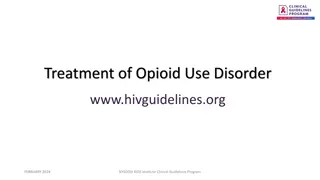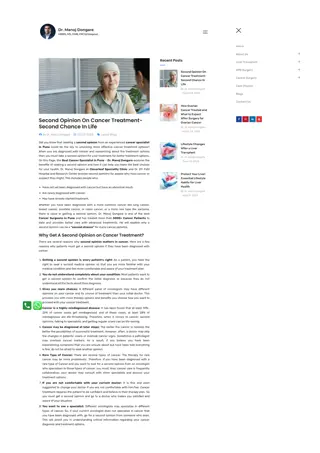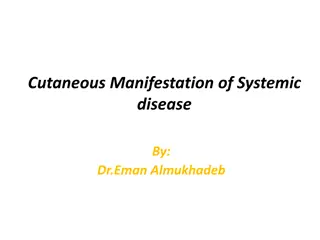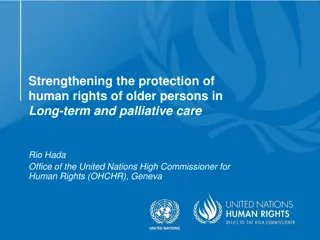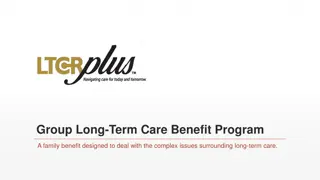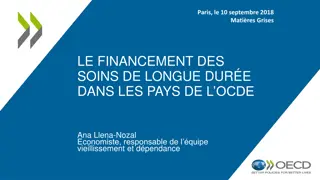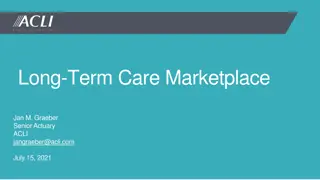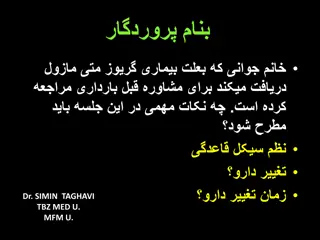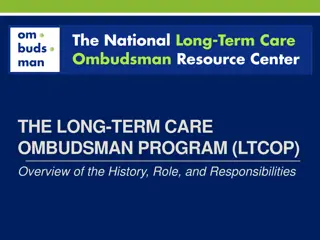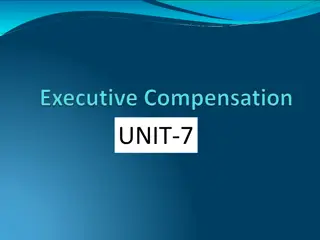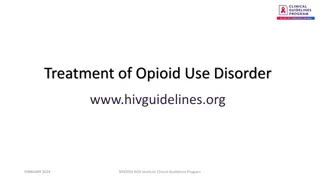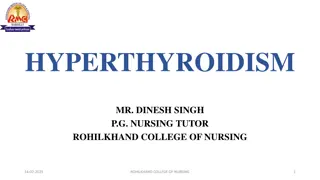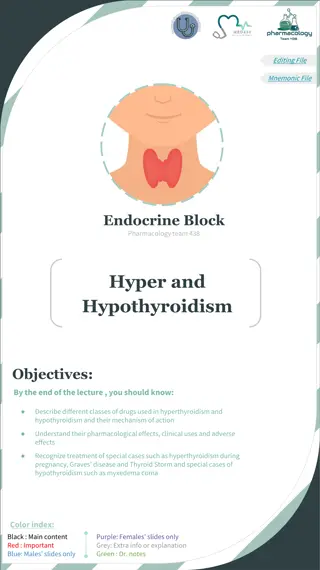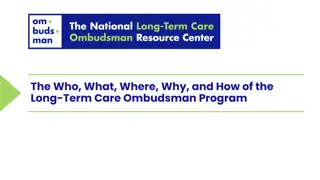Hyperthyroidism Treatment Options and Long-Term Consequences
In the treatment of hyperthyroidism, achieving a euthyroid state is key. This article discusses radioiodine therapy as a preferred treatment due to safety and efficacy, along with the risk of hypothyroidism post-therapy and issues with levothyroxine replacement. Long-term consequences, such as thyroid failures and increased dependence on thyroxine, are also highlighted.
Download Presentation

Please find below an Image/Link to download the presentation.
The content on the website is provided AS IS for your information and personal use only. It may not be sold, licensed, or shared on other websites without obtaining consent from the author.If you encounter any issues during the download, it is possible that the publisher has removed the file from their server.
You are allowed to download the files provided on this website for personal or commercial use, subject to the condition that they are used lawfully. All files are the property of their respective owners.
The content on the website is provided AS IS for your information and personal use only. It may not be sold, licensed, or shared on other websites without obtaining consent from the author.
E N D
Presentation Transcript
Introduction The most obvious objective in the treatment of hyperthyroidism is to render the patient euthyroid off drug therapy. The major drawback of treatment with thionamide drugs for hyperthyroidism is the frequent reappearance of thyrotoxicosis, up to 20-70% when therapy is discontinued. Therefore, increasingly considered the treatment of choice because of its safety and ease of administration. radioiodine is 3
INTRODUCTION Reasons for increased reliance in radioiodine treatment: Atrial fibrillation due to hyperthyroidism Cardiovascular and cerebrovascular morbidity High relapse after discontinuation of antithyroids Ease, effectiveness and low cost 4
Long Term Consequences of RAI Therapy: Thyroid failures 50-70% to 90-100% Morbidity from vascular causes (? Due to hyperthyroidism itself) Cancer incidence and mortality Dependency on thyroxine therapy 5
Problems with hypothyroidsm after RAI therpy 1. Occurs in 50-70% of patients after low dose and in 90-100% following high dose radioiodine treatment. Many years after the patient has attained euthyroidism by radioiodine (long-term follow up of thyroid function). The risk of over replacement of levothyroxine on the heart and bones. Dubious potency, uniformity and reproducibility of thyroxine preparations. Lack of compliance. 2. 3. 4. 5.
Patients under levothyroxine replacement therapy may be at risk for consequences of under- and over- treatment 32% of patients on levothyroxine replacement therapy had abnormal TSH concentrations, while 92% of them had seen a health care provider the previous year. In the Colorado Thyroid Disease Prevalence Study of patients who reported taking thyroid medication, nearly 40% had an abnormal serum TSH level In Tehran Thyroid Study 21.1% of radioiodine-induced hypothyroid patients on levothyroxine therapy, had elevated TSH during the 10 years of follow up.
Number of patients with worsening of preexisting TAO [10 of 22 patients (45%) in group I; and nine of 19 patients (47%) in group M] and de novo development of TAO [53 of 141 patients (38%) in group I; and 23 of 131 patients (18%) in group M] at any time during follow-up Trasik F, et al, 2009; 94: 3700
The Kaplan-Meier curves for worsening or development (W/D) of ophthalmopathy between treatment with iodine-131 (163 patients) and medical therapy for Graves hyperthyroidism (150 patients) (A); smokers (121 patients) vs. nonsmokers (190 patients) (B); nonsmokers who received medical therapy (86 patients) vs. iodine-131 treatment (104 patients) (C); and smokers who received iodine-131 (59 patients) vs. medical therapy (62 patients) (D). The markers on the x-axes represent ophthalmology assessments according to the protocol. Trasik F, et al, 2009; 94: 3700
Outcome of very long-term treatment with antithyroid drugs in Graves hyperthyroidism associated with Graves orbitopathy Laura Elbers, Maarten Mourits and Wilmar Wiersinga Thyroid 2011, in press 1. After a median 3.5 year ATD therapy, relapse rate was 37% 1. Long term ATD therapy of patients until Graves orbitopathy has become inactive is accompanied by no worsening of GO
TSH receptor autoimmunity in Graves disease after therapy 70 60 50 40 TRAb % 30 Radioiodine Surgery 20 10 Medication 0 0 1 2 3 4 5 Years Laurberg et al EJE 2008
Factors favoring relapse of thyrotoxicosis after treatment of Graves disease with thionamides More consistent factors: Severe degree of thyrotoxicosis Large goiter Lack of decrease of goiter size during therapy High T3 to T4 ratio in serum Higher baseline levels of anti-TSH receptor antibodies Lack of normalization of serum TSH Inconsistent factors: Sex, age, cigarette smoking, duration of symptoms before diagnosis, presence of ophthalmopathy, psychiatric disorders, (depression, hypochondriasis, paranoia, mental fatigue) and problems of daily life Azizi F. Exper Opin Drug Saf 2006; 5: 107-116
Comparison of remission rate at 6, 12, and 24 months after ATD discontinuation between the H-TSH and N-TSH groups Choo YK, et al. Thyroid 2010; 20: 949
Advantages and Disadvantages of Available Treatment Modalities for Graves Disease Thyrotoxicosis Treatment Modality Radioiodine Advantages Disadvantages Definitive treatment of thyrotoxicosis Rare, mild and transient side effects No surgical risks Easy to perform Fast Delayed control of thyrotoxicosis Lower efficacy in large goiters Radiation hazard (?) CVD, cancer Possible appearance of ophthalmopathy Worsening of preexisting ophthalmopathy Problems with treatment of hypothyroidism Thyroidectomy Definitive treatment of thyrotoxicosis No radiation hazards Removal of large goiters Fast High cost Hypoparathyroidism (0.9%-2%) ` Bleeding/infections/anesthesia Scarring Thionamides No radiation hazards No surgical risks No permanent hypothyroidism Low cost Frequent relapses Requires frequent testing Side effects and adverse reactions
In patients with recurrent hyperthyroidism after disontinution of antithyroid drugs, long term (mean 10 years) continuous treatment with methimazole (MMI) was safe, and had comparable expense and complications with radioiodine treatment Azizi F, et al. Europ J Endocrinol 2005; 152: 695 15
PATIENTS AND METHODS Clinical trial Between march 1989 and July 2009 Mean follow up 14 3 (range 5-20) years Patients with diffuse toxic goiter Tehran; area of iodine sufficiency 59 patients on MMI and 73 on levothyroxine for treatment of radioiodine induced hypothyroidism Followed every 3-6 months with TFT s for mean of 14 years 16
The relative risk and confidence interval (CI) of variables in the continuous MMI treated (group 1), as compared with the radioiodine induced hypothyroid patients (group 2) Variable Relative risk(95%CI) P Value During follow up TSH<0.3 mU/l 1.95(1.4-2.72) <0.01 TSH>5 mU/l 3.6 (2.52-5.06) <0.01 At final visit 0.38(0.16-0.92) <0.05 Antithyroperoxidase antibody>100 mU/l 0.51(0.27-0.95) <0.05 Total goiter rate 2.18(1.12-4.22) <0.03 Serum cholesterol>200 mg/dl 1.9(1.13-3.33) <0.02 Serum LDL-C>130 mg/dl Number BMD<1.5 SD Z score 1.12(0.55-2.26) NS Vertebra 1.44(0.81-2.57) NS Hip 1.4(0.74-2.68) NS Radius 0 2 4 6 Azizi F. Europ J Endocrinol 2005; 152: 695 In favor of Group 1 In favor of Group 2
Patients with recurrent hyperthyroidism (104) Randomization Radiiodine therapy (51) MMI treatment (34) Excluded (29) LFU (10) LFU (6 ) Hyper (1) Hypothyroid (25) Hypo (1) Euthyroid (16) Euthyroid(26) Thyroxine treated Euthyroid (25) Non MMI R% Euthyroid (33) RAI R% Randomized Hypothroid on T4 R% (48) MMI (59) RAI (73) 18
Health Status and Neuro-psychology Tests Name of test Assessment 1. SF 36 Health Survey Questionnaire General health 2. General Health Questionnaire (GHQ) Mental disorders 3. Rey Complex Figure Test Cognitive processes 4. Bender-Gestalt test (BGT) Cognitive ability 5. Wechsler Memory Scale-Revised (WMSR) Memory 6. Wechsler Adult Intelligence Scales (WAIS) Intelligence quotient 7. Symptom Checklist-90 (SCL-90) Psychological distress 8. Hospital Anxiety and Depression Scale (HADS) Anxiety & Depression 19
Age, BMI and physical activity in methimazole and radioiodine treated patients at final visit Variable MMI (n=59) RAI (n=73) P Adjusted P (sex) Gender (F/M) 41/18 62/11 0.02 Age (yr) 51 16 53 11 0.53 0.65 BMI (kg/m2) 26.2 3.5 27.8 4.5 0.04 0.143 Physical activity (%) Mild 53 77 0.009 0.012 Moderate 47 23 0.006 Goiter rate (%) 62 3 0.001 0.001 TPOAb (IU/ml) 23 8 0.001 0.001 (7-82) (5-15) TRAb (U/ml) 2.1 1.8 0.02 0.86 (1.6-3.6) (1.4-2.2) 20
Serum lipids and lipoproteines concentrations in methimazole and radioiodine treated patients 219 34 112 22 192 36 102 23 * CHOLESTERL 200 SERUM LDL-C 100 (mg/dl) (mg/dl) 50 100 0 0 MMI RAI MMI RAI 52 10 167 47 11 (120-212) TRIGLYCERIDES SERUM HDL-C 115 50 * (mg/dl) (90-152) (mg/dl) 100 25 0 MMI RAI 0 MMI RAI 21 * p<0.001, p<0.02
Findings of echocardiography in methimazole and radioiodine treated patients 100 240 149 45 153 43 78 75 left ventricular mass (gm) 160 Ejection fraction (%) 50 80 0 0 MMI RAI MMI RAI 20 8 14.9 4.3 5.7 1.8 7 Early diastolic annular velocity ( ) 4.8 4.3 15 6 Earlydistolic ( E/ ) ratio 11.5 45 5 (cm) 10 4 3 5 2 1 0 0 MMI RAI MMI RAI P<0.001 P<0.02 22
Occurrence of abnormal serum TSH in methimazole and radioiodine treated patients during mean 15 years follow up 80 71.2 60 Frequency (%) 41.7 40 33.8 MMI 27.1 RAI 20 13.8 9.7 1.7 0 0 0 1-3 4-6 >6 Occurance of TSH>5 mU/L (TIMES) P<0.001 100 84.3 80 Frequency (%) 60 44.4 42.7 MMI 40 RAI 20 11.9 11.1 6.8 2.8 0 0 0 1-3 4-6 >6 Occurance of TSH <0.3 mU/L (TIMES) P<0.04 23
Summary statistics and p values for neuro-psychologic tests Measure MMI (n=59) RAI (n=73) P SCL - 90 Compulsion Normal & marginal 48 (81)* 61 (84) 0.281 Abnormal 11 (19) 12 (16) Psychotic Normal & marginal 53 (90) 61 (84) 0.046 Abnormal 6 (10) 12 (16) WMSR Direction 5 (5-6) 5 (4-5) 0.033 Logical memory 6 (4-7) 4 (3-6) 0.049 Repeating numbers 9 (8-11) 9 (8-11) 0.010 Memory score 96.6 13.9 93.6 13.9 NS WAIS Intelligence quotient 107 20 99 15 0.02 *:Number in parenthesis denote percentage; : numbers are median (interquartile interval); mean SD SCL- 90: . Symptom Checklist-90 WMSR: Wechsler Memory Scale-Revised; WAIS: Wechsler Adult Intelligence score 24
The relative risk and confidence interval of the rate of occurrence of bone mineral density <-1 SD Zscore and velocity <12 and 16.8 cm and early diastolic (E)/ ratio <6.7 in continuous MMI- treated, compared to radioiodine-treated patients Relative risk (95% CI) P Value Variable At final visit
CONCLUSIONS (1) Long-term continuous MMI tratement: Effective Safe, rare side effects High treatment compliance Comparable expense with RAI therapy 26
CONCLUSIONS (2) Long-term continuous MMI tratement compared to thyroxine- treated RAI-induced hypothyroidism: More physical activity More goiter Better lipid profile Higher TPOAb titers Better memory, mood and IQ Less psychotic Less subclinical hypo-and hyperthyroidism 27
CONCLUSIONS (3) Continuous methimazole treatment should be considered as an optional approach to long term treatment of patients with diffuse toxic goiter, in particular those with recurrent hyperthyroidism. 28
Algorithm for the Use of Antithyroid Drugs among Patients with thyrotoxicosis Small or moderately enlarged thyroid; children or pregnant or lactating women; patients with severe eye disease Very large diffuse goiter, multinodular goiter, toxic adenoma Radioiodine therapy Antithyroid drug therapy ? surgery Discontinue drug therapy after 18 mo Normalization of thyroid function With antithyroid drugs before therapy in elderly patients and those with heart disease Monitor thyroid function Relapse Remission Monitor thyroid function every 12 mo indefinitely Definitive radioiodine therapy Second course of antithyroid drug therapy in children and adolescents Continuous MMI therapy
Thyrotoxicosis in pregnancy Occurs in 0.2% of women Mostly caused by Graves disease
Management of Hyperthyroidism in Pregnancy Antithyroid drugs should be initiated in women with Graves hyperthyroidism or a toxic nodule in pregnancy. PTU is preferred in the first trimester. Following the first trimester, patients should be changed to methimazole. A block-replace regimen with both LT4 and ATD should not be used in pregnancy. Azizi F. Expert Opin Daug saf 2006; 5: 107 Mandel SJ et al. J Clin Endocrinol Metab 2001; 86: 2354 Bahn RS et al. Thyroid 2009; 19:673
WHICH TESTS SHOULD BE PERFORMED DURING TREATMENT WITH ATD AND WHAT LEVELS SHOULD BE ACHIEVED? An estimate of free T4 (FT4I )and TSH should be monitored approximately every 4 weeks. The primary goal is a serum free T4 at or just above the upper limit of the normal range. Momotani N et al. N Engl J med 1986; 315: 24
Should anithyroid drug therapy be discontinued in the last part of pregnancy? Can postpartum recurrence of Graves disease be prevented by the continuation of antithyroidis during pregnancy?
Postpartum recurrence and exacerbation Postpartum recurence and exacerbation of Graves' hyperthyroidism of Graves hyperthyroidism 6 5 Number of patients 4 ATD withdraw ATD continued 3 2 1 0 1 2 3 4 5 6 7 8 9 10 11 12 Months after delivery Nekagawa et al. Clin Endocrinol 57: 467,2002
What are the long-term effects of antithyroid treatment in pregnancy on growth, intellectual development and thyroid function of the offspring?
Anthropometric data, serum thyroid hormones, and TSH, Urinary iodine, thyroid antibodies, and liver function tests in children of thyrotoxic mothers and control group Parameters Children of thyrotoxic mothers (n=23) Controls (n=30) Age at testing (yr) 5.61 1.9 5.7 2.0 Sex 7M/16F 11M/19F Height (cm) 113 11 111 13 Weight (kg) 18.0 5.2 19.7 7.9 T4 ( g/dl) 9.7 2.2 9.5 2.0 T3 (ng/dl) 147 33 142 40 TSH (mU/l) 1.25 0.5 1.45 0.6 RT3Up (%) 28.3 2.2 28.7 2.1 Urinary iodine ( g/dl) 22.3 11.7 20.5 8.5 Anti Tg (IU/ml) 52.4 41.5 62.6 50.0 Anti TPO (IU/ml) 32.9 31.1 43.6 37.1 Azizi et al. J Endocrinol Invest 2002;25:586
Wechsler tests scores in children whose mothers were taking methimazol (MMI) ( ), and in control ( ). 20 control case 15 IQ (verbal) 10 5 0 Information Vocabulary Mathe matics Similarities Comprehension Sentences Azizi et al.J Endocrinol Invest 2002;25:586
WHAT IS THE VALUE OF TSHRAB MEASUREMENT IN THE EVALUATION OF A PREGNANT WOMAN WITH GRAVES HYPERTHYROIDISM? If the patient has a past or present history of Graves disease, a maternal serum measure of TSHRAb should be obtained at 22-26 weeks gestation. Lution O et al. J Clin Endocrinol Metab 2005; 90: 6093 Laurberg P et al. Europ J Endocrinol 2009;160: 1-8 Zwaveling- Soonawala N et al. Thyroid 2009; 19: 661-2.
UNDER WHAT CIRCUMSTANCES SHOULD ADDITIONAL FETAL ULTRASOUND MONITORING FOR GROWTH, HEART RATE, AND GOITER BE PERFORMED IN WOMEN WITH GRAVES HYPERTHYROIDISM IN PREGNANCY? Fetal surveillance should be performed in women who have uncontrolled hyperthyroidism or who have highly elevated TSHRAb titers. Such monitoring may include ultrasound monitoring for heart rate, growth, and fetal goiter. Papendieck P et al. J Ped Endocrinol Metabol 2009; 22: 547
Management of thyrotoxicosis in pregnancy Confirm diagnosis Start propylthiouracil or methimazole Render patient euthyroid: continue with low-dose ATD up to and during labor and postpartum Monitor thyroid function: Throughout gestation; adjust ATD if necessary to maintain T4 at upper level of normal Check TSAb at 26 weeks Discuss treatment with patient effect on patient effect on fetus breast feeding Inform obstetrician and pediatrician Review postpartum-check for exacerbation
HOW SHOULD WOMEN WITH GRAVES DISEASE BE COUNSELED PRE-PREGNANCY? Hyperthyroidism should be well controlled before attempting pregnancy. Patients on anti-thyroid drugs should be switched to PTU when pregnancy is being attempted or at time of conception (?). In patients with high titers of TRAb antibodies requiring definitive therapy for Graves disease in the setting of a planned pregnancy within the next two years, surgery is preferable to radioactive iodine (?).
TSH receptor autoimmunity in Graves disease after therapy 70 60 50 40 TRAb % 30 Radioiodine Surgery 20 10 Medication 0 0 1 2 3 4 5 Years Laurberg et al EJE 2008
A proposed algorithm for the systemic approach to suspected pregnant women for hyperthyroidism Serum FT4 (FT4I) , TSH Normal FT4 (FT4I), TSH High FT4 (FT4I), suppressed TSH Normal Adjusted TT3 History of Graves , goiter, ophthalmopathy Nausea, vomiting, weight loss Normal Increased Positive TPOAb TBII Pelvic Ultrasonography Repeat TFT s after first trimester, if indicated (+) (-) PTU in the first trimester; adjust to have FT4 at upper level of normal, switch to MMI after 12 weeks, check TSAb at 22-26 weeks Hydatidiform mole Gestational thyrotoxicosis Supportive therapy Surgery
SUBCLINICAL THYROTOXICOSIS Decreased Thyrotropin normal L- thyroxine and triiodothyronine and no complains; Exogenously caused by L- thyroxine treatment Endogenous prevalence up to 20% in multinodular goiter Increased risk for atrial fibrillation, slightly increased bone turnover and decreased bone mineral density in postmenopausal women Antithyroid drug treatment is indicated in endogenous subclinical thyrotoxicosis fibrillation A trial of antithyroid drug thrapy in asymptomatic patients remains debatable. associated with atrial 44


